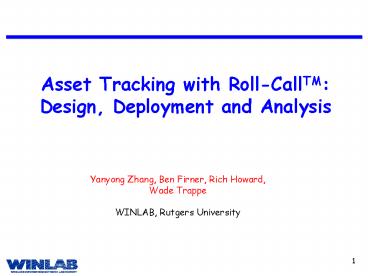Asset Tracking with RollCallTM: Design, Deployment and Analysis - PowerPoint PPT Presentation
1 / 12
Title:
Asset Tracking with RollCallTM: Design, Deployment and Analysis
Description:
1. Asset Tracking with Roll-CallTM: Design, Deployment and Analysis. Yanyong Zhang, Ben Firner, Rich Howard, Wade Trappe. WINLAB, Rutgers University. 2 ... – PowerPoint PPT presentation
Number of Views:48
Avg rating:3.0/5.0
Title: Asset Tracking with RollCallTM: Design, Deployment and Analysis
1
Asset Tracking with Roll-CallTM Design,
Deployment and Analysis
Yanyong Zhang, Ben Firner, Rich Howard, Wade
Trappe WINLAB, Rutgers University
2
Asset Tracking Applications
- We envision that an efficient asset tracking
application should - Continuously track the position of each item
- Detect the missing of an item in real time
- E.g., jewelry tracking
3
Limitations with Existing RFID
Passive RFID Tags Inexpensive Long Lifetime -
Poor Range
Active RFID Tags Good Range - More Expensive -
Short Lifetime - Larger
Im still here!
Obstacle
Obstacle
Anyone there?
Passive Tag Reader
Active Tag Receiver
4
Our Solution Roll-CallTM
- Tag
- Tag periodically announces its ID.
- Receiver disabled.
- Life time 1 year.
- Basestation
- Receives and timestamps the packets, then
transfer them to the processing station
- Multiple receives used to provide overlapping
coverage. - Central Processing Unit
- Tracks the tags using data from multiple
receivers.
5
Challenges Packet Losses
- Packet losses can lead to false alarms.
- There are three types of losses
- Ambient losses due to radio environment
Solution better placement of basestations
6
Challenges Packet Losses
- Packet losses can lead to false alarms.
- There are three types of losses
- Ambient losses due to radio environment
- Collision losses
- Random transmissions lead to collisions
- Our model shows that in a 100-tag system with
each tag transmitting a 100 bit packet in 100ms
epochs, the collision probability is 5
7
Challenges Packet Losses
- Packet losses can lead to false alarms.
- There are three types of losses
- Ambient losses due to radio environment
- Collision losses
- Dead-time losses due to unavailability of the
basestation - Processing time
- Transfer time
Solution Reduce the processing at the
basestation, and buffering the packets for a
batch transfer
8
Throughput Limit Test
- Experiment setup a tag transmits 20,000 packets
at different packet intervals - Combining buffering and use of multiple
basestations achieves the best performance
9
Raw Packet Loss Ratio
Packet loss ratio
Number of basestations
10
Presence Detection
- Raw packet loss ratio information is not fed into
applications instead, we need to detect whether
a tag is missing - Declare miss ratio (DMR)
- how resilient a detection scheme is against
packet losses - n packet losses, out of which we detect m tag
misses, then the DMR is m/n - Report Latency (RL)
- The interval between the last when a tag was
heard and the time it was declared missing given
that it is actually lost - Detection Heuristics
11
Conclusions and Future Directions
- The initial Roll-CallTM design is promising
- Packet losses should be further reduced
- More enhancements are on the way
- Extracting information from collided packets
- Employing basestations with multiple processors
- More sophisticated detection algorithms are
needed - Will extensively study the performance in
different environments
12
Questions Answers

